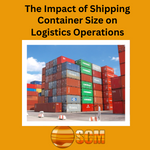

Shipping containers are the unsung heroes of global trade, facilitating the movement of goods across borders and continents. However, the size of these containers plays a pivotal role in shaping the efficiency and cost-effectiveness of logistics operations. In this article, we will delve into the various container sizes, their implications for transportation and storage, and explore the dynamic relationship between container size and logistics operations.
Introduction to Shipping Container Sizes
Shipping containers come in a range of sizes, each tailored to meet specific needs and accommodate various types of cargo. The two most prevalent container sizes are the 20-foot (TEU) and 40-foot (FEU) containers. While these are the standard sizes, smaller and larger alternatives are also available to cater to diverse requirements. The selection of container size hinges on factors such as cargo volume and type, ultimately shaping the logistics landscape. In the ensuing sections, we will examine the different sizes of shipping containers and analyze their impact on logistics operations.
Transportation Considerations for Different Container Sizes
Transportation forms the backbone of logistics operations, and container size plays a crucial role in determining its efficiency and cost. Larger containers, such as the 40-foot containers, possess a larger cargo capacity, reducing the number of trips required to transport goods. This advantage leads to potential cost savings and increased operational efficiency. However, the transportation of larger containers necessitates specialized equipment, such as larger trucks or ships, which incurs additional costs. In contrast, smaller containers, like the 20-foot counterparts, are more suitable for smaller shipments and situations where space is constrained. Such containers are often preferred for their cost-effectiveness and adaptability. When planning transportation logistics, carefully considering container size is imperative to ensure optimal efficiency and cost-effectiveness.
Storage and Handling Challenges for Larger Containers
While larger containers offer transportation benefits, they introduce unique challenges in terms of storage and handling. Warehouses and storage facilities must be equipped with larger doors and higher ceilings to accommodate these containers comfortably. Failure to account for this requirement can impede the smooth flow of logistics operations. Furthermore, the loading and unloading of larger containers demand specialized equipment, such as cranes and forklifts. These additional logistical considerations highlight the importance of assessing the size of shipping containers to ensure seamless operations throughout the supply chain.
Cost Implications of Container Size for Logistics Operations
Container size significantly impacts the cost structure of logistics operations. Larger containers necessitate more substantial investments in equipment and facilities, as well as higher transportation costs due to the need for specialized vehicles. However, these larger containers can yield cost savings by reducing handling and transportation time, ultimately enhancing efficiency. It is crucial to conduct a comprehensive cost-benefit analysis to determine the most economically viable container size for logistics operations. Moreover, considering the cargo volume and characteristics will enable businesses to make informed decisions about container size selection.
Future Trends and Innovations in Shipping Container Design


As the logistics industry continues its trajectory of innovation, so does the design of shipping containers. One notable trend gaining prominence is the use of lightweight materials like aluminum and composite materials. By reducing container weight, these materials increase payload capacity, enabling businesses to transport more goods in a single container. This innovation translates into cost savings and enhanced operational efficiency. Additionally, the advent of smart containers equipped with sensors and tracking technology revolutionizes the logistics landscape. These intelligent containers provide real-time information on the location and condition of goods, enabling businesses to monitor their assets more effectively and optimize supply chain operations. The integration of lightweight materials and smart technologies in container design showcases the industry’s commitment to improving efficiency and reducing costs in logistics operations.
Key Statistics and Tables:
To enhance the depth of analysis and provide a comprehensive understanding of the impact of shipping container size on logistics operations, the following statistics and tables are presented:
- Table 1: Common Shipping Container Sizes and Their Specifications
| Container Size (FEU) | Length (ft/m) | Payload Capacity |
| 20-foot (TEU) | 20 ft / 6.1 m | 20,000 kg |
| 40-foot (FEU) | 40 ft/12.2 m | 26,500 kg |
| 45-foot | 45 ft / 13.7 m | 26,500 kg |
| 53-foot | 53 ft / 16.2 m | 29,500 kg |
- Table 2: Comparison of Costs and Benefits for Different Container Sizes
| Consideration | | 20-foot Container | 40-foot Container |
| Cargo Capacity | Lower | Higher |
| Transportation Costs | Lower | Higher |
| Storage Requirements | Less space required | More space required |
| Handling Equipment | Standard | Specialized |
| Suitable for | smaller shipments | larger shipments |
These statistics and tables aim to provide readers with a comprehensive overview of shipping container sizes, their specifications, and the associated costs and benefits. By utilizing this information, businesses can make informed decisions regarding container size selection, leading to improved logistics operations.
Shipping container size plays a vital role in shaping the efficiency and cost-effectiveness of logistics operations. The choice between different container sizes requires careful consideration of transportation requirements, storage and handling capabilities, and cost implications. Businesses must conduct a comprehensive cost-benefit analysis to determine the optimal container size for their logistics operations. Additionally, as the industry continues to evolve, lightweight materials and smart technologies are being integrated into container design, promising further enhancements in efficiency and cost reduction.
Understanding the impact of shipping container size on logistics operations is essential for businesses seeking to optimize their supply chains. By leveraging the advantages of the right container size, companies can enhance operational efficiency, reduce costs, and remain competitive in the ever-evolving global marketplace.
Check out our Blog for more logistics insights, tips and news

